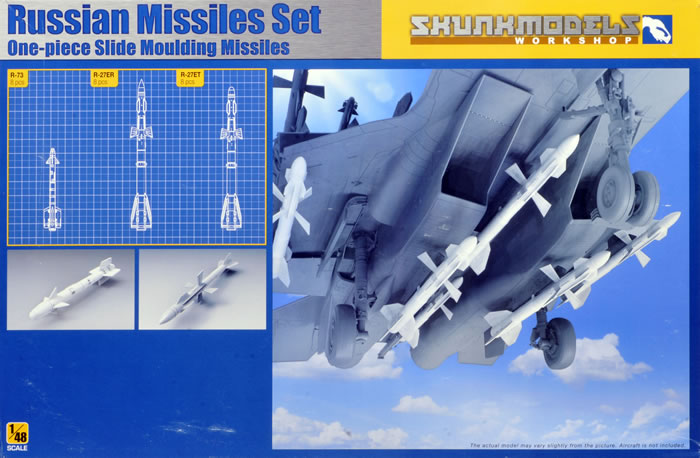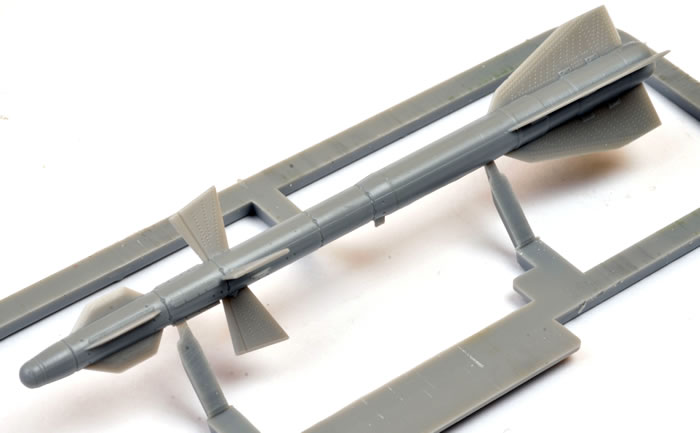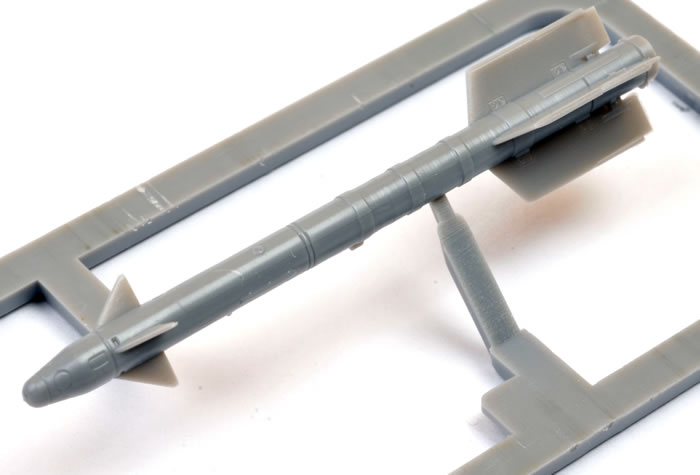Russian Missiles Set

Skunkmodels Workshop, 1/48 scale
S u m m a r y |
| Item No. |
Skunkmodels Workshop Item No. SW48029 - Russian Missiles Set |
| Contents and Media: |
142 parts in grey plastic; four small photo-etched frets (makes up 8 x R-73 missiles, 8 x R-27ER missiles, 8 x R-27ET missiles and 24 pylons). |
| Scale |
1/48 |
| Price: |
USD$29.98
plus shipping available online from Lucky Model |
| Review Type: |
FirstLook |
| Advantages: |
High level of detail; clever moulding of one-piece missiles. |
| Disadvantages: |
|
| Recommendation: |
Maximum detail for minimum effort. Highly Recommended. |
Reviewed
by Brett Green

HyperScale is proudly supported by Squadron.com
R-73 Missile Background
The R-73 was developed to replace the earlier R-60 (AA-8 'Aphid') weapon for short-range use by Soviet fighter aircraft. Work began in 1973, and the first missiles entered service in 1984.
The R-73 is an infrared homing (heat-seeking) missile with a sensitive, cryogenic cooled seeker with a substantial "off-boresight" capability: the seeker can "see" targets up to 40° off the missile's centerline. It can be targeted by a helmet-mounted sight (HMS) allowing pilots to designate targets by looking at them. Minimum engagement range is about 300 meters, with maximum aerodynamic range of nearly 30 km (19 mi) at altitude. The weapon is used by the MiG-29, MiG-31, Su-27, Su-34 and Su-35, and can be carried by newer versions of the MiG-21, MiG-23, Sukhoi Su-24, and Su-25 aircraft. India is looking to use the missile on their HAL Tejas. It can also be carried by Russian attack helicopters, including the Mil Mi-24, Mil Mi-28, and Kamov Ka-50/52.
The R-73 is a highly maneuverable missile and mock dogfights between USAF and German Air Force MiG-29s (inherited from the former Air Forces of the National People's Army) equipped with the R-73/helmet mounted cueing have indicated that the high degree of "off-boresight" capability of the R-73 would make a significant difference in combat. The missile also has a mechanically simple but effective system for thrust-vectoring. The R-73 prompted the development of a number of western air-to-air missiles including the IRIS-T, MICA IR, Python IV and the latest Sidewinder variant, the AIM-9X which entered squadron service in 2003.
From 1994, the R-73 has been upgraded in production to the R-73M standard, which entered CIS service in 1997. The R-73M has greater range and a wider seeker angle (to 60° off-boresight), as well as improved IRCCM (Infrared Counter-Counter-Measures). Further developments include the R-74 (izdeliye 740) and its export variant RVV-MD. Russia currently receives new improved air-to-air missiles on the basis of the R-73.
An improved version of the R-74, the K-74M (izdeliye 750) features fully digital and re-programmable systems, and is intended for use on the MiG-35 or MiG-29K/M/M2 and Su-27SM, Su-30MK and Su-35S. A further upgrade, known as the K-74M2 (izdeliye 760), is intended for the fifth-generation Sukhoi PAK FA aircraft. This missile has reduced cross section to fit in internal weapon bays and will match the performance of the AIM-9X and the ASRAAM. A clean sheet design, the K-MD (izdeliye 300), will supersede the K-74M2 in the future.*

R-27 Missile Background
The Vympel R-27 missile (NATO reporting name AA-10 Alamo) is a medium-to-long-range air-to-air missile developed by the Soviet Union. It remains in service with the Russian Air Force and air forces of the Commonwealth of Independent States.
-
The R-27 is manufactured in infrared-homing (R-27T), semi-active-radar-homing (R-27R), and active-radar-homing (R-27EA) versions, in both Russia and Ukraine. The R-27 missile is carried by the Mikoyan MiG-29 and Sukhoi Su-27 fighters, and some of the later-model MiG-23MLD fighters have also been adapted to carry it. The R-27 missile is also license-produced in China, although the production license was bought from Ukraine instead of Russia.
-
R-27R AA-10 Alamo-A, semi-active radar homing. Missile can be used at 20 to 25000 meters altitude (launch platform or target). Effective kill range for a target at same altitude: 2 to 42.5 km head-on, 0.7 to 7.5 km tail-on. Maximum range: 73 km. Maximum allowed vertical separation between target and launch platform: +/- 10 km.
-
R-27T AA-10 Alamo-B, infrared homing, passive homing using the Avtomatika 9B-1032 (PRGS-27) IR seeker head. Missile can be used at 20 to 25000 meters altitude. Effective kill range for a target at same altitude: 2 to 33 km head-on, 0 to 5.5 km tail-on. Maximum range: 63 km. Maximum allowed vertical separation: +/-10 km.
-
R-27ER AA-10 Alamo-C, the semi-active-radar homing extended-range version. Missile can be used at 20 to 27000 meters altitude. Effective kill range for a target at same altitude: 2 to 65.5 km head-on, 0.7 to 16.5 km tail-on. Missile cannot be fired at altitude less than 3 km againist a target with background earth, if launch range is less than 6 kilometers. Maximum range: 117 km. Maximum allowed vertical separation: 12 km.
-
R-27ET AA-10 Alamo-D, the infrared-homing extended-range version, Weight 348 kg. Missile can be used at 20 to 27000 meters altitude. Effective kill range: 2 to 52.5 km head-on, 0.7 to 12.5 tail-on. Maximum range: 104 km. Maximum allowed vertical separation: 12 km.
-
R-27R and ER variants can be used in any meteorological conditions. Launch can made at less than 5 g overload and less 50 deg/s roll rate. It is allowed to redesignate targets during flight, or sharing target illumination with other aircraft.
R-27T and ET variants can be used out of cloudiness, at least 15 degrees away from the bearing of sun, and 4 degrees away from the bearing of moon and ground based head-contrasting conditions. In cases of maximum head-on range launches where lock-command cannot be utilised, missile can be fired in PPS: In this mode, missile will fly straight until achieves target lock. As missile lacks capability of maneuvering before lock, aircraft itself must maneuver so that missile will be pointed to no more than 15 degrees bearing of the target for confident capture by the IR seeker after launch. Equalising altitude is recommended but not required. On combat operations section of the Su-27 manual, this mode of usage is especially recommended for head-on usage for passive attacks at targets with 0 degrees approach angle (i.e. another fighter moving to intercept), leaving target unalerted to incoming missile. Launch can be made at 0 to 7 g, but limited to 6 g if roll induced slip is more than 2x diameter of the ball.
Although the size of the ball may be different here, the same idea of slip affecting launch performance applies.
Other Variants:
-
R-27P AA-10 Alamo-E, passive radar homing with a range of up to 72 km.
-
R-27EP AA-10 Alamo-F, a longer range passive anti-radiation missile with a range of up to 70 nm (110 km)
-
R-27EA, active radar homing with 9B-1103K active seeker, range of >130 km.
This is a supremely simple yet elegantly detailed set of 1/48 scale missiles.

We've seen these already in Kinetic's gorgeous 1/48 scale Su-33 kit, but it is nice that they are now more generally available in this after market accessory set.

There are 142 parts in light grey plastic.
Contents are as follows:
-
8 x R-73 missiles
-
8 x R-27ER missiles
-
8 x R-27ET missiles
-
24 x pylons

Each missile is a single moulding inside a sprue "cage", and these in turn are packed into a cardboard tray of six missiles each.
Fins are delicately rendered and the missile bodies feature fine recessed and raised detail.
A number of different styles of single and multi-part pylons are also included.
Instructions for assembly and loadout are printed on the back of the box.
Moulding quality is excellent. All that is required is to free the missiles from their sprue cages, and a little cleanup of some very fine moulding seams with a hobby knife.
If you are planning to build a modern Soviet aircraft and need to add weapons, this missile set offers the maximum detail for minimal effort.
Highly Recommended.
*Historical background courtesy of Wikipedia
Thanks to Lucky Model for the samples
Review Text and Images Copyright © 2016 by
Brett Green
Page Created 13 September, 2016
Last updated
14 September, 2016
Back to HyperScale Main Page
Back to Reviews Page
|
Home
| What's New |
Features |
Gallery |
Reviews |
Reference |
Forum |
Search